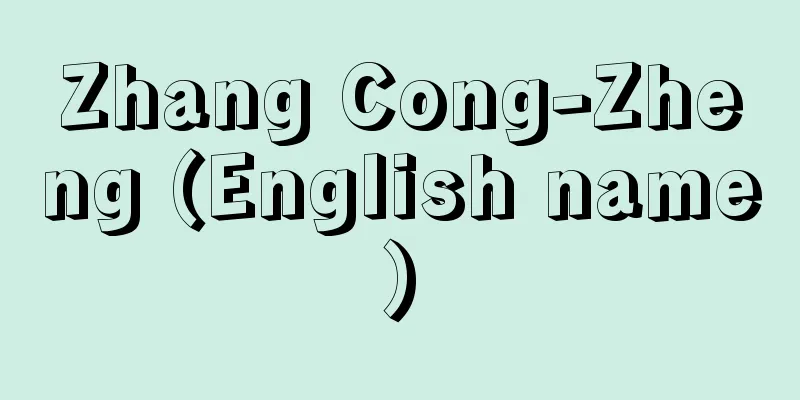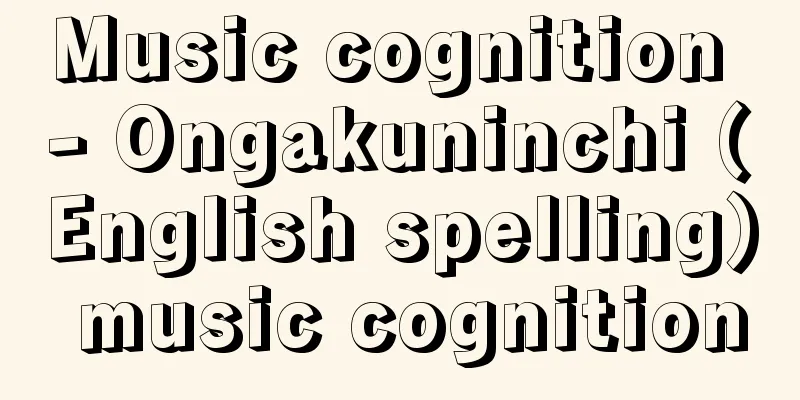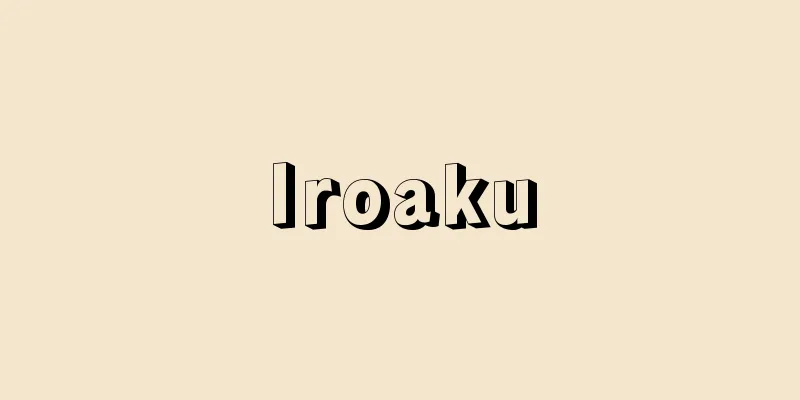Umbrella - Parasol

|
In contrast to a hat worn over the head, an umbrella held in the hand is called a kasa or sashigasa. In Japan, umbrellas were used as sunshades by aristocrats and monks in the olden days, but in the mid-Kamakura period they began to be used as rain umbrellas. Furthermore, when parasols for children appeared in the mid-Edo period, they also came to be used by adults. [Takeshi Endo] JapanUmbrellas were originally imported goods from abroad, and were first brought to Japan as a gift from King Seongmyeong of Baekje during the reign of Emperor Kinmei (mid-6th century). These umbrellas, called kinugasa, were made of cloth stretched around the umbrella and had tassels attached, and were used as long-handled umbrellas by retainers who held them over the heads of the emperor and nobles during ceremonies and when going out. When Buddhist culture flourished in the Kamakura period, vermilion-lacquered long-handled umbrellas covered in paper were used by monks, and in the Edo period they were used as tsumaori umbrellas when accompanying lords on their alternate attendance trips or to the castle. In the private sector, in particular in the red-light districts of the entertainment district, tayu (court ladies' courtesans) would use long-handled umbrellas bearing their family crest when they traveled about, and this style was indispensable in the performances of plays such as the Kabuki play "Kago Tsurube Sato no Yoizame." [Takeshi Endo] umbrellaOn the other hand, umbrellas as rain gear are seen in picture scrolls, such as the Kamakura period "Ippen Shonin Eden" or "Honen Shonin Eden," which have a wheel-type opening and closing mechanism using rush grass. In the Edo period, umbrellas covered with paper appeared. Umbrella-covering craftsmen can be seen in the Muromachi period "Seventy-one Craftsmen's Collection," and also in Kano Yoshinobu's "Craftsmen's Collection Screens" (owned by Kitain Temple in Kawagoe City) bearing the jar seal, but all of these umbrellas have long handles. The handle was shortened to make it a rainy day umbrella, known as the "Tsunbo Umbrella" made by Daikokuya. This umbrella has a thick handle and ribs and is very sturdy, and was made in Osaka from washi paper coated with perilla oil. These umbrellas were brought to Edo and became the umbrellas of townspeople from around the Genroku period (1688-1704), and were made in Edo during the Shotoku period (1711-1716) and were called bangasa (bamboo umbrellas). After that, umbrellas with snake-eye patterns, slave umbrellas, or maple leaf umbrellas were made. Janome umbrellas are umbrellas with navy blue paper pasted around the center and edges, and blank in the middle; they were so named because when the umbrella is opened, a thick ring-like janome pattern appears. They originated in the Genroku period as an improved version of the Daikoku umbrella. Instead of navy blue paper, shibu janome umbrellas are pasted with paper colored with red ocher and called shibu janome, and were mostly used in Kamigata. In Edo, umbrellas called yakkanome were preferred, with a light ink color around the edges and no black center. These were not used in Kamigata. The momiji umbrella is a particularly high-quality umbrella with a slender handle wrapped in split rattan, with navy blue paper above the central rib and blank paper everywhere else, and decorated with silk costumes. [Takeshi Endo] parasolIn addition to rain umbrellas, there were also parasols. These were originally used by children. In the early Edo period, both men and women would cover their faces with cloth, which was called a mask and was indispensable when going out. However, in the mid-17th century, a plot by ronin to overthrow the shogunate was discovered, and the shogunate issued an edict banning masks. As a result, both men and women were forced to walk around with their faces bare, and adults began to use parasols instead of hats. Parasols became established as a women's item during the Horeki era (1751-1764). At the end of the Edo period, double-top umbrellas appeared, which could be used not only as parasols but also as rain umbrellas. Many of these were made in the Kamigata region. Their distinctive features were that the curve of the umbrella was gentler than that of a rain umbrella, and the paper was thinly coated with perilla oil in case of rain. After the ports were opened to the public, Western culture was also introduced to the ports. In Yokohama, merchants and samurai alike would use silk umbrellas with 8 or 16 ribs made from Western iron. These silk umbrellas later became bat umbrellas, which could be used in both rain and shine, and could even be used as walking sticks, becoming symbols of modernization. From the mid-Meiji period onwards, iron-handled umbrellas with flippers and especially women's umbrellas became increasingly beautiful with Western-style tassels around the silk covering and lace, and umbrellas with handles longer than the ribs became fashionable. Deep-cover umbrellas were called "beautiful woman umbrellas" and were made from high-quality fabrics such as Kai silk, wool satin and amber weave. Meanwhile, parasols appeared towards the end of the Meiji period as Western-style parasols, and in the "Records of the Opening of Yokohama Port" there is a picture of a woman walking around with one at the port. It was not until the Taisho period that parasols became popular. [Takeshi Endo] WesternIn English, rain umbrellas are generally distinguished as umbrellas and parasols as parasols or sunshades, but from an etymological point of view, both are parasols. In other words, umbrella is a diminutive form of the Latin umbra, meaning "shadow," which entered Italian as ombrella, and originally meant "something that creates shadow." On the other hand, parasol also comes from the Italian parasole, meaning "protection from the sun." The distinction between umbrellas (rain umbrellas) and parasols (sun umbrellas) began to appear in English around 1750. However, in French, ombrelle is a small parasol for women, and parapluie is literally a rain shelter, that is, a clear distinction between them as rain umbrellas, and umbrellas that can be used in both rain and shine are called en-tout-cas. The origins of umbrellas are probably as old as the emergence of humans, since humans likely used the large leaves of natural trees to protect themselves from the sun and rain. However, the role of the umbrella eventually expanded from these physical and physiological aspects to include psychological and social aspects. In other words, umbrellas came to have religious significance as symbols of status and power, and sometimes as a symbol of regenerative power, representing the shadow of humans. Umbrellas originated in the ancient Orient and spread from east to west. In ancient India, traces of umbrellas date back to around 2000 BC, while they eventually evolved into Buddhist stupas and towers. Ceremonial umbrellas in ancient Mesopotamia date back to Assyria in the 14th century BC. Umbrellas in ancient Egypt date back to the Middle Kingdom in the 13th century BC. There, umbrellas were not just for shade, but also represented the vault, or sky, and were symbols of shade and honor. In ancient Greece and Rome, umbrellas were also seen on priests during processions and on coffins during funerals, but were also commonly used as shade for women. Ordinary umbrellas were made from palm leaves and bamboo, but in later times, parasols with ivory handles dyed reddish purple and decorated with gold patterns also appeared. In the Middle Ages, umbrellas, which were not so uncommon in Asia and Africa, were still rare in Europe. Umbrellas, which were passed down from the Byzantine Empire to ancient Rome, spread to Europe through the Catholic Church in Medieval Europe, but they were more than just umbrellas, being used as canopies to show rank and prestige and were placed over kings and clergy. In Europe, umbrellas were generally considered effeminate, and therefore were not used for a long time. Thus, parasols were introduced to France in 1533 by Catherine de' Medici, wife of Henry II, who married into the Medici family of Italy. In the 17th century, umbrellas became less rare among the upper classes. Louis XIII had five satin parasols in 1619, and 18 years later, an oilcloth umbrella with gold and silver lace trim. In 1660, when the Spanish princess Maria Theresa came to Paris after marrying Louis XIV, she was seen sitting in a carriage with a small parasol, and in a copperplate print by Saint-Jean in 1678, a woman was depicted strolling with a parasol. In the 18th century, the parasol, or rain umbrella, became as fashionable as the parasol. In Britain, the word "umbrella" was established in the early 18th century. The modern-day one-person bat-shaped umbrella was invented in the mid-18th century by the British Jonas Hanway, went on sale in 1787, and became common in the early 19th century. The metal-ribbed umbrella was invented by the British Samuel Fox & Co. in 1847, and umbrellas quickly became popular after that. [Akira Ishiyama] Current UmbrellaAfter the Second World War in Japan, as lifestyles became more westernized and highly waterproof synthetic fibers began to be used for umbrella fabric, production of Western umbrellas increased, and by the 1950s, production of Western umbrellas had surpassed that of Japanese umbrellas. Folding umbrellas and jump umbrellas (one-touch umbrellas) also became popular. The ribs of a Western umbrella are composed of ribs that directly support the umbrella fabric, support ribs that support the ribs, and a center pole that acts as the main pillar in the center of the umbrella. The standard number of ribs is eight for a typical long umbrella and a folding umbrella that folds in two stages, and six for a folding umbrella that folds in three or more stages, but there are various types of umbrellas for reasons of design and durability, such as long umbrellas with ten or more ribs. The ribs and support ribs are made of steel, fiberglass, carbon fiber, and aluminum, while the center pole is made of aluminum, steel, carbon fiber, fiberglass, and wood. The length of the ribs is related to the size of the umbrella when it is opened, and it is mandatory under the Household Products Quality Labeling Act to display this size and the type of fabric. The length of the ribs varies depending on the purpose of use, and the standard is 65 cm for men's long umbrellas and 55 to 60 cm for folding umbrellas, and 60 cm for women's long umbrellas and 50 to 55 cm for folding umbrellas, but there are large umbrellas for each type and even smaller umbrellas for women. The standard for long umbrellas for school children is 38 cm for kindergarteners, 50-55 cm for lower grades of elementary school, and 60 cm for upper grades. Umbrella fabrics are made of fibers such as polyester, nylon, silk, cotton, and linen, as well as vinyl film, and each type is used for rain umbrellas and parasols depending on its characteristics. Domestic umbrella production was around 40 million units in the early 1980s, but was pushed out by cheap imports, and by 1987 (Showa 62) imported goods surpassed domestic production, and domestic production in 2006 (Heisei 18) was only 1.59 million units. The amount of imported umbrellas in 2008 was 129 million units, most of which were made in China, and more than 90% were cheap vinyl umbrellas. [Editorial Department] “Ruiju Early Modern Fuzokushi” by Morisada Kitagawa (1934, Shoseikaku) ▽ “TS CrawfordA History of the Umbrella (1970, David & Charles, Newton Abbot, Great Britain)” [Reference] | |The Chinese umbrellas and long-handled umbrellas with claws, which were mainly used by monks, and raincoats can be seen . Rain gear from the Kamakura period A drawing of a folding umbrella with the tip of the rib bent inward. Split rattan is wrapped around the slender handle, and the umbrella is decorated with silk thread. Kitagawa Morisada, "Moriso Manko", Vol. 30, National Diet Library Claw folding umbrella Patterns on a janome umbrella. The one on the right is a black janome, and the one on the left is a slave janome. Kitagawa Morisada, "Morizada Manko", Vol. 30, National Diet Library Janome Umbrella A silk umbrella from the Meiji period. It was called a "wombrella" and it is said that "when folded, it can be used as a walking stick." Katayama Junnosuke, Western Clothing, Food and Living, 1867 (Keio 3), Preface, National Diet Library Silk Umbrella Source: Shogakukan Encyclopedia Nipponica About Encyclopedia Nipponica Information | Legend |
|
頭髪にかぶる笠(かさ)に対して、手に持つ「かさ」を傘あるいは差し傘という。日本では、古くは貴族たちや僧侶(そうりょ)たちの間で日除(ひよ)け傘として使用されたが、鎌倉時代中期になると雨傘として用いられるようになった。さらに江戸時代中期に、子供用の日傘が登場すると、これが大人の間にも利用されるに至った。 [遠藤 武] 日本傘は、元来外来文化の舶載品であり、日本に初めてもたらされたのは欽明(きんめい)天皇の時代(6世紀中ごろ)に、百済(くだら)の聖明王から贈られたものである。これは蓋(きぬがさ)といわれ傘の周りに裂(きれ)を張り巡らして房をつけ、長い柄(え)の長柄傘として、儀式や外出のおりに天皇をはじめ公家(くげ)たちの頭上に従臣が差しかけて用いた。長柄傘は鎌倉時代に仏教文化が盛んになると、僧侶の間で紙張りをした朱塗傘が用いられ、江戸時代には大名の参勤交代あるいは登城など、供揃(ともぞろ)えのときに爪折(つまおり)傘として用いられた。民間では特殊な社会、つまり廓(くるわ)で太夫(たゆう)が道中をする際に、定紋をつけた長柄傘を用いたが、この姿は歌舞伎(かぶき)『籠釣瓶花街酔醒(かごつるべさとのよいざめ)』などの舞台では欠くことのできないものである。 [遠藤 武] 雨傘一方、雨具としての傘は、絵巻物、たとえば鎌倉時代の『一遍上人(いっぺんしょうにん)絵伝』あるいは『法然(ほうねん)上人絵伝』などによるとイグサを使ったろくろ式の開閉装置のあるものがみられる。江戸時代になると紙張りのものが出てくる。傘張りの職人は室町時代の『七十一番職人尽(づくし)』のなかにみられ、また狩野吉信(かのうよしのぶ)の壺(つぼ)印のある『職人尽絵屏風(びょうぶ)』(川越市喜多院蔵)のなかにもみられるが、これらの傘はいずれも長柄傘である。柄の長さを短くして雨天用の差し傘としたのが、大黒屋の「つんぼ傘」といわれるものである。この傘は柄も骨も太くて頑丈そのもので、和紙に荏油(えのあぶら)を引き、大坂でつくられた。それが江戸へ運ばれてだいたい元禄(げんろく)年間(1688~1704)から町民の傘となり、正徳(しょうとく)年間(1711~1716)には江戸でもつくられて番傘といった。その後、雨傘には蛇の目(じゃのめ)傘、奴(やっこ)傘あるいは紅葉(もみじ)傘などがつくられた。 蛇の目傘は、傘の中央と端の周りに紺土佐(こんどさ)の紙を張り、中間を白紙にしたもので、傘を開くと、太い輪の蛇の目模様が現れるところから名づけられた。元禄年間に大黒傘を改良してつくったのに始まる。紺土佐のかわりに渋にべんがら(弁柄)を加えて色づけした紙を張ったものを渋蛇の目といい、上方(かみがた)での利用が多かった。また江戸では、奴蛇の目といって周囲を薄墨(うすずみ)にして、傘の中央を黒くしない傘を好んだ。これは上方では用いられなかった。紅葉傘は傘のなかでとくに細身の柄に割い籐(さいとう)を巻き、中央の骨つがいから上を紺土佐、それ以外を白紙とし、糸装束などを飾った上等のものである。 [遠藤 武] 日傘傘は雨傘以外に日傘があった。これは元来は子供のさすものであった。江戸時代初期、男女ともに布帛(ふはく)で顔を包み隠すことが行われ、これを覆面といって、外出には欠くことのできないものであった。ところが17世紀中ごろ、浪人たちによる幕府転覆計画が発覚し、幕府は覆面の禁令を発布した。このため男女ともに素顔で歩かざるをえなくなり、笠(かさ)のかわりに、大人も日傘を用いるようになった。女性のさし物として日傘が定着したのは、宝暦(ほうれき)年間(1751~1764)からである。幕末になって、単なる日傘ばかりではなく、雨傘としても使える両天(りょうてん)傘が現れた。これは多く上方でつくられた。その特色は、傘の反りが雨傘より傾斜が緩やかであり、雨のときを考えて、紙に荏油を薄く引いたことである。また開港となってからは、欧米文化が開港場に取り入れられていった。横浜では貿易商をはじめ武士も、西洋製の鉄でつくられた8骨ないしは16骨の絹傘を用いるものがあったという。この絹傘が後のこうもり傘で、晴雨両用となり、さらに杖(つえ)(ステッキ)ともなり、文明開化の表徴とされた。 明治も中期以降になると、鉄の柄に、はじき付き、ことに女物のこうもり傘は、絹張りの周囲に欧米風に房飾りをつけたり、レースを施すなどしだいに美しさを増していき、骨より柄の長いものが流行した。また深張りのものを美人傘とよんで、甲斐絹(かいき)、毛繻子(けじゅす)、琥珀織(こはくおり)などの高級織物を用いた。一方、明治の終わりごろからパラソルparasolが洋風の日傘として出現し、『横浜開港見聞誌』には、開港場で女性がさして歩いている図がみられる。パラソルが大衆化するのは大正に入ってからである。 [遠藤 武] 西洋英語では一般に雨傘をアンブレラumbrella、日傘をパラソルparasolまたは日よけsunshadeとして区別するが、この二つは語源上からするとどちらも日傘である。つまり、アンブレラは「影」の意のラテン語umbraがイタリア語に入ってombrellaと指小辞化したもので、もともと「影をつくるもの」を意味した。一方、パラソルもイタリア語の「太陽から守る」意のパラソーレparasoleからきている。アンブレラ(雨傘)とパラソル(日傘)の使用区分が英語に現れるのは1750年ころのことである。ただし、フランス語ではオンブレルombrelleは婦人用の小さい日傘、パラプリュイparapluieは字義どおり雨よけ、つまり雨傘として明確に区分されており、晴雨兼用の傘はとくにアン・トゥー・カen-tout-casとよばれている。 傘の始まりは、おそらく人間の発生と時を同じくするくらいに古いということができよう。なぜなら、大きな自然の木の葉を、人間は日よけ、雨よけに用いたであろうから。しかし、傘の役割はそうした物理的・生理的側面から、やがては心理的・社会的側面へと拡大していく。すなわち、身分や権力の象徴として、ときには人間の影を意味する再生力の表徴として、宗教的意味合いをもつようになるからである。 もともと傘は古代オリエントに始まり、そこから東西に伝播(でんぱ)していった。古代インドではその痕跡(こんせき)を紀元前2000年ごろまでさかのぼる一方、やがてそれは仏教におけるストゥーパ(卒塔婆(そとば))や塔へと発展していく。古代メソポタミアにおける儀式用の傘は前14世紀のアッシリアにまでさかのぼる。また古代エジプトでの傘は前13世紀の中王国時代にまでさかのぼる。そこでの傘は単に日よけだけでなく、穹窿(きゅうりゅう)つまり天空を意味するものであり、陰と名誉の象徴なのであった。古代ギリシアやローマでも、傘は行列の際の神官や葬列での柩(ひつぎ)などにみられる一方、女性用の日よけとして一般的に用いられた。人々の普通の傘はシュロの葉と竹などでつくられたが、後代になると、赤紫に染め金の模様を施した象牙(ぞうげ)の柄(え)の日傘も登場するようになる。 中世に入って、アジア、アフリカではそれほど珍しくなかった傘も、ヨーロッパではまだまれな存在であった。帝政時代の古代ローマからビザンティンへと受け継がれた傘は、中世ヨーロッパのカトリック教会を通じてヨーロッパへと広まったが、それは高位と威信を表す天蓋(てんがい)として、王や聖職者などに差しかけられたもので、単なる傘以上のものであった。ヨーロッパでは、傘は一般にめめしいものと考えられたためか、長い間用いられなかった。こうしてフランスにパラソルが導入されるのは、1533年、イタリアのメディチ家から嫁したアンリ2世妃カトリーヌ・ド・メディシスによってのことであった。17世紀に入ると、傘は上層社会ではそれほど珍しくなくなってくる。ルイ13世は1619年に5本のサテンの日傘、18年後には金銀レースの縁飾りのある油布の雨傘をもっていた。またスペイン王女マリア・テレジアが1660年、ルイ14世に嫁してパリにやってきたとき、小さな日傘をさして馬車に座っているし、サン・ジャン作の1678年の銅版画には、日傘をさして散歩する婦人が描かれている。パラプリュイつまり雨傘は、18世紀になると日傘と並ぶおしゃれの道具になった。 イギリスでも、雨傘を意味するアンブレラの語が定着するのは18世紀初めである。そして今日的一人ざしのこうもり形の洋傘が発明されたのは、イギリスのハンウェイJonas Hanwayによって18世紀なかばのことであり、それが販売されるのは1787年、一般化するのは19世紀初めであった。金属骨の傘がイギリスのサムエル・フォックス社によって発明されたのは1847年で、以後傘は急速に普及した。 [石山 彰] 現在の傘第二次世界大戦後の日本において、生活が洋風化し、また防水性の高い化学繊維が傘生地に用いられるようになると、洋傘は生産を伸ばし、昭和30年代には和傘の生産量を上回るようになった。折り畳み傘、ジャンプ傘(ワンタッチ傘)も普及した。 洋傘の骨は、傘生地を直接支える親骨、親骨を支える受け骨、傘の中心で主柱の役割をなす中棒から構成される。標準的な親骨の数は、一般的な長傘と、2段に折れるタイプの折り畳み傘では8本、3段以上に折れる折り畳み傘では6本だが、10本以上の親骨をもつ長傘など、デザインや耐久性などの理由からさまざまなものがある。親骨、受け骨の素材には、鉄、グラスファイバー、カーボンファイバー、アルミニウムなどが、中棒にはアルミニウム、鉄、カーボンファイバー、グラスファイバー、木などが用いられている。傘を開いた大きさに関係するのが親骨の長さであり、この寸法と生地の種類を表示することは、家庭用品品質表示法で義務づけられている。親骨の長さは使用対象により異なり、標準的なものは、紳士用の場合は長傘で65センチメートル、折り畳み傘で55~60センチメートル、婦人用では長傘が60センチメートル、折り畳み傘が50~55センチメートルだが、それぞれに大判のものもあり、また婦人用ではさらに小ぶりのものもある。学童用の長傘は幼稚園児で38センチメートル、小学校低学年で50~55センチメートル、高学年で60センチメートルが使用の目安になっている。傘生地にはポリエステル、ナイロン、絹、木綿、麻などの繊維や、ビニールフィルムなどが用いられ、それぞれの特性により雨傘、日傘などに使い分けられている。 国内の洋傘生産量は、1980年代前半には約4000万本前後であったが、安価な輸入品におされ、1987年(昭和62)には輸入品が国産品を上回り、2006年(平成18)の国内生産量は159万本にすぎない。2008年の洋傘輸入量は1億2900万本で、そのほとんどは中国製、9割以上が安価なビニール傘である。 [編集部] 『喜多川守貞著『類聚近世風俗志』(1934・更生閣)』▽『T. S. CrawfordA History of the Umbrella(1970, David & Charles, Newton Abbot, Great Britain)』 [参照項目] | | | |おもに僧侶の間で使われた唐傘や爪折の長柄傘と雨衣がみられる。『一遍上人絵伝』 写国立国会図書館所蔵"> 鎌倉時代の雨具 親骨の先端部を内側に折り曲げた爪折傘の図。細身の柄に割いた籐を巻き、糸装束が施されている。喜田川守貞著『守貞漫稿』 巻30国立国会図書館所蔵"> 爪折傘 蛇の目傘の模様。右が黒蛇の目、左が奴蛇の目。喜田川守貞著『守貞漫稿』 巻30国立国会図書館所蔵"> 蛇の目傘 文明開化期の絹張り傘。「ヲンブレラ」とよび、「畳んだときは杖のかわりに用いる」とある。片山淳之助著『西洋衣食住』 1867年(慶応3)序刊国立国会図書館所蔵"> 絹傘 出典 小学館 日本大百科全書(ニッポニカ)日本大百科全書(ニッポニカ)について 情報 | 凡例 |
Recommend
John Roebuck
English inventor and industrialist. Born in Sheff...
MN blood type
…Parent-child identification [Yasuhiro Nakajima]....
Record of training - Denshuuroku
This book is a collection of dialogues and letter...
Detection limit -
The smallest amount or concentration of a substanc...
Calceola
…In Japan, characteristic species and genera have...
Obshchestvo iskusstva i literatury (English notation) Obshchestvoiskussstvai literatury
At the age of 14, he organized a family theater c...
Iwatahara Plateau - Iwataharadaichi
A plateau that spreads across the western Shizuok...
Auburn Prison - Auburn Prison
...After a battle between solitary confinement (t...
Somatotype
...Also, attempts to classify body types, such as...
Edouard Herriot
French politician. He started out as a high schoo...
Oriya - Oriyago
...There is a considerable movement of population...
Dog Clutch - Dog Clutch
…Usually, the clutch can be engaged or disengaged...
Crete [island] - Crete
A Greek island in the eastern Mediterranean, about...
Algal mat
...A sedimentary structure consisting of laminae ...
Allegorical capital - Guiichiutou
…These capitals were inherited by Islamic archite...









